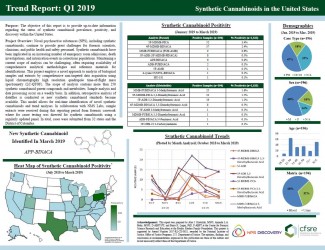Synthetic Cannabinoids in the United States; Trend Report: Q1 2019
To download the report, please visit: https://forum.issup.net/t/synthetic-cannabinoids-in-the-united-states-trend-report-q1-2019/4153
Purpose: The objective of this report is to provide up-to-date information regarding the status of synthetic cannabinoid prevalence, positivity, and discovery within the United States.
Project Overview: Novel psychoactive substances (NPS), including synthetic cannabinoids, continue to provide great challenges for forensic scientists, clinicians, and public health and safety personnel. Synthetic cannabinoids have been implicated in an increasing number of emergency room admissions, death investigations, and intoxication events in corrections populations. Maintaining a current scope of analysis can be challenging, often requiring availability of comprehensive analytical methodologies and reference materials for identifications. This project employs a novel approach to analysis of biological samples and extracts by comprehensive non-targeted data acquisition using liquid chromatography high resolution quadrupole time-of-flight mass spectrometry (LC-QTOF). The scope of analysis contains more than 250 synthetic cannabinoid parent compounds and metabolites. Sample analysis and data processing occur on a weekly basis. In addition, retrospective analysis of datafiles is conducted as new synthetic cannabinoid standards become available. This model allows for real-time identification of novel synthetic cannabinoids and trend analyses. In collaboration with NMS Labs, sample extracts were received during this reporting period from forensic casework where for cause testing was directed for synthetic cannabinoids using a regularly updated panel. In total, cases were submitted from 32 states and the District of Colombia.
This report was prepared by Alex J. Krotulski, MSFS; Amanda L.A. Mohr, MSFS, D-ABFT-FT; and Barry K. Logan, PhD, F-ABFT at the Center for Forensic Science Research and Education at the Fredric Rieders Family Foundation. This project is supported by Award Number 2017-R2-CX-0021, awarded by the National Institute of Justice, Office of Justice Programs, U.S. Department of Justice. The opinions, findings, and conclusions or recommendations expressed in this publication are those of the authors and do not necessarily reflect those of the Department of Justice.

- ISSUP members can join Networks to comment – Sign in or become a member